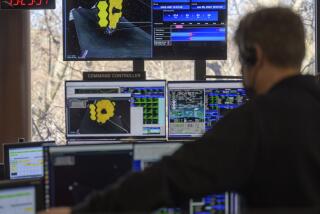Lockheed to Move 1,000 Jobs to Antelope Valley
- Share via
PALMDALE — Lockheed Martin Corp., continuing the consolidation it began more than a year ago, said Tuesday it will move its aircraft services division from Ontario to Palmdale, bringing about 1,000 workers from San Bernardino County to the Antelope Valley.
The aerospace giant already has about 3,500 employees at its famed Skunk Works facility in Palmdale, where it designs top-secret military aircraft.
The relocation of the aircraft services business to the company-owned plant in Palmdale was not unexpected, following the announcement last December that management and administration of the two divisions would be consolidated.
But it means that Lockheed Martin, which once had employees spread throughout Southern California, will have centralized nearly all its regional operations at one location.
The move will begin immediately, and will be completed in the first half of 1998, the announcement said. Up to 500 of the aircraft services division’s current employees will be laid off; the remaining 1,000 will be asked to transfer to Palmdale, and will be offered relocation and commuting assistance.
The company portrayed the consolidation as a cost-saving move necessitated by the economics of shrinking defense budgets.
“This plan will enable us to preserve a large number of jobs, while becoming more competitive and maintaining the commitments we have made to our customers,” said Skunk Works President Jack Gordon.
Bob Toone, Palmdale’s city manager, said the 1,000 new jobs are good news for the local economy, which is slowly recovering from a real estate downturn earlier in the decade.
“It’s certainly going to help us,” he said. “It will certainly help the housing market.”
The aircraft services unit, which has been located in Ontario since 1952, repairs and refurbishes used planes. At its peak around 1980, the division had about 3,000 workers, but in recent years it has been hit by declining defense budgets and keen competition for a limited number of contracts.
Lockheed Martin spokesman Ron Lindeke said the move will be carried out gradually, as the unit’s two current military contracts are phased out in Ontario. The division is currently doing modification work on an Air Force C130 special mission aircraft, and is refurbishing 18 A-4M Skyhawk jet fighters for the government of Argentina.
The C130 work will be transferred to Palmdale, Lindeke said, enabling the company to keep 1,000 of the aircraft services workers.
Vern Lawson Jr., executive director of the Antelope Valley Local Development Corp., said that even if only some of the aircraft services workers relocate to Palmdale, the community will benefit “because wealth is injected into the economy.”
Lawson said it also bodes well for the future that the aircraft services unit does maintenance work on commercial planes, giving it the ability to ride out downturns in defense contracts.
Palmdale is hoping for another dose of favorable employment news in the next few months.
The Skunk Works--which developed the F-117 radar-evading Stealth fighter plane, the U-2 spy plane, and the SR-71 Blackbird surveillance plane--is hoping to win two new government contracts that are due to be announced by July. One is for the X-33, an experimental version of a reusable spaceship that could lead to a replacement for the space shuttle. The other is for a next-generation tactical fighter aircraft.
If Lockheed Martin wins either program, it could lead to up to 1,000 new jobs over the next six months, Lindeke said.
Lockheed Martin, based in Bethesda, Md., has been streamlining operations and slashing jobs since the historic $10-billion merger of Lockheed Corp. and Martin Marietta Corp. was completed in March 1995, creating the nation’s largest aerospace concern. Three months after the merger, the company announced the closing of 12 plants and the elimination of 12,000 jobs worldwide.
But so far, Lockheed Martin’s California operations have been spared most of the deepest cuts--save for the relocation of some administration jobs from Lockheed’s former Calabasas headquarters to Maryland.
The changes at the company haven’t ended, however. In March, Lockheed Martin again dramatically altered the landscape of the defense industry with its acquisition of the defense electronics business of Loral Corp. in a deal valued at more than $9 billion.
The Loral deal is expected to boost Lockheed Martin’s annual sales another 25%, to about $30 billion. But if past patterns in the industry are repeated, it signals that the consolidation of the defense and aerospace business has yet to run its course.
More to Read
Inside the business of entertainment
The Wide Shot brings you news, analysis and insights on everything from streaming wars to production — and what it all means for the future.
You may occasionally receive promotional content from the Los Angeles Times.











